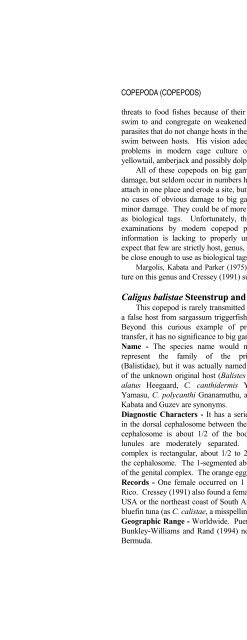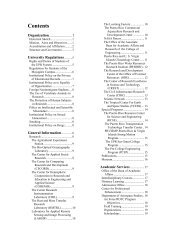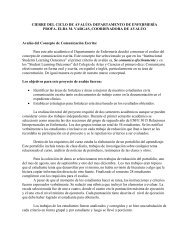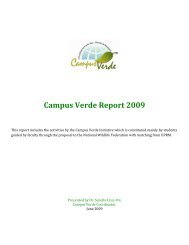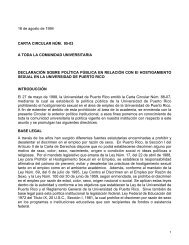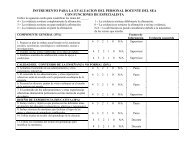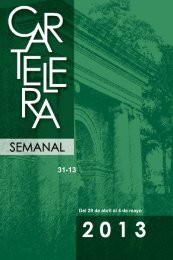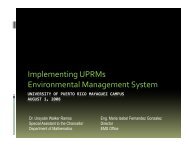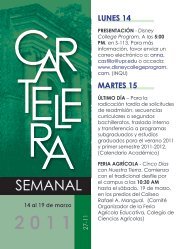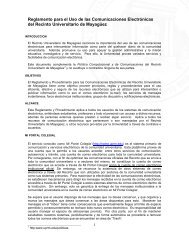- Page 2:
PARASITES OF OFFSHORE BIG GAME FISH
- Page 6:
2 Cover drawing: Atlantic blue marl
- Page 10:
INTRODUCTION The purpose of this bo
- Page 14:
INTRODUCTION Host Summaries and Hos
- Page 18:
DEFINITIONS AND CONVENTIONS vive lo
- Page 22:
PROTOZOA (PROTOZOANS) MYXOZOA (MYXO
- Page 26:
PROTOZOA (PROTOZOANS) Trypanosoma s
- Page 30:
PROTOZOA (PROTOZOANS) Goussia clupe
- Page 34:
MYXOZOA (MYXOZOANS) Significance to
- Page 38:
FUNGI (FUNGUS) The fungal-like orga
- Page 42:
FUNGI (FUNGUS) Ecology - This is an
- Page 46:
UDONELLIDEA (COPEPOD WORM) Diagnost
- Page 50:
DIGENEA (FLUKES) Flukes are permane
- Page 54:
DIGENEA (FLUKES) Stephanostomum meg
- Page 58:
DIGENEA (FLUKES) Location in Host -
- Page 62:
DIGENEA (FLUKES) found that the sma
- Page 66:
DIGENEA (FLUKES) Associations - We
- Page 70:
DIGENEA (FLUKES) Records - Two occu
- Page 74:
DIGENEA (FLUKES) and distinctive or
- Page 78:
DIGENEA (FLUKES) does not extend to
- Page 82:
DIGENEA (FLUKES) Tergestia laticoll
- Page 86:
DIGENEA (FLUKES) rhynchus with 7 te
- Page 90:
DIGENEA (FLUKES) Length - 0.7-1.3 m
- Page 94:
DIGENEA (FLUKES) Host Specificity -
- Page 98:
DIGENEA (FLUKES) Coitocaecum extrem
- Page 102:
DIGENEA (FLUKES) Location in Host -
- Page 106:
DIGENEA (FLUKES) Stephanostomum meg
- Page 110:
DIGENEA (FLUKES) Pseudopecoeloides
- Page 114:
DIGENEA (FLUKES) a new host record
- Page 118:
DIGENEA (FLUKES) in the fish intest
- Page 122:
DIGENEA (FLUKES) The oral sucker is
- Page 126:
DIGENEA (FLUKES) USA. It probably o
- Page 130:
DIDYMOZOIDEA (TISSUE FLUKES) is acc
- Page 134:
DIDYMOZOIDEA (TISSUE FLUKES) Subfam
- Page 138:
DIDYMOZOIDEA (TISSUE FLUKES) in the
- Page 142:
DIDYMOZOIDEA (TISSUE FLUKES) Damage
- Page 146:
DIDYMOZOIDEA (TISSUE FLUKES) relati
- Page 150:
DIDYMOZOIDEA (TISSUE FLUKES) occurr
- Page 154:
DIDYMOZOIDEA (TISSUE FLUKES) hold u
- Page 158:
DIDYMOZOIDEA (TISSUE FLUKES) Miscel
- Page 162:
MONOGENEA (GILLWORMS) Family Hexost
- Page 166:
MONOGENEA (GILLWORMS) Life History
- Page 170:
MONOGENEA (GILLWORMS) worms from ye
- Page 174:
MONOGENEA (GILLWORMS) boundary of t
- Page 178:
MONOGENEA (GILLWORMS) they may be p
- Page 182:
MONOGENEA (GILLWORMS) Host Specific
- Page 186:
MONOGENEA (GILLWORMS) Allopyragraph
- Page 190:
MONOGENEA (GILLWORMS) Records - One
- Page 194:
MONOGENEA (GILLWORMS) Geographic Ra
- Page 198:
MONOGENEA (GILLWORMS) 1-4 Gotocotyl
- Page 202:
MONOGENEA (GILLWORMS) Diagnostic Ch
- Page 206:
MONOGENEA (GILLWORMS) Tristomella l
- Page 210:
CESTODA (TAPEWORMS) Classification
- Page 214:
CESTODA (TAPEWORMS) Rico, and more
- Page 218:
CESTODA (TAPEWORMS) hope the follow
- Page 222:
CESTODA (TAPEWORMS) Length - Pleroc
- Page 226:
CESTODA (TAPEWORMS) in 2 of 5 dolph
- Page 230:
CESTODA (TAPEWORMS) These larval fo
- Page 234:
CESTODA (TAPEWORMS) Ecology - The f
- Page 238:
CESTODA (TAPEWORMS) from the scolex
- Page 242:
CESTODA (TAPEWORMS) gill arches of
- Page 246:
CESTODA (TAPEWORMS) Ecology - Membe
- Page 250:
CESTODA (TAPEWORMS) Dasyrhynchus gi
- Page 254:
CESTODA (TAPEWORMS) Ceratobothrium
- Page 258:
CESTODA (TAPEWORMS) further subdivi
- Page 262:
CESTODA (TAPEWORMS) Location in Hos
- Page 266:
NEMATODA (ROUNDWORMS) 133 Roundworm
- Page 270:
NEMATODA (ROUNDWORMS) Roundworms ar
- Page 274:
NEMATODA (ROUNDWORMS) otherwise it
- Page 278:
NEMATODA (ROUNDWORMS) Diagnostic Ch
- Page 282:
NEMATODA (ROUNDWORMS) Hysterothylac
- Page 286:
NEMATODA (ROUNDWORMS) posterior to
- Page 290:
NEMATODA (ROUNDWORMS) Records - We
- Page 294:
NEMATODA (ROUNDWORMS) their midpart
- Page 298:
NEMATODA (ROUNDWORMS) presence of t
- Page 302:
NEMATODA (ROUNDWORMS) Harm to Human
- Page 306: NEMATODA (ROUNDWORMS) Geographic Ra
- Page 310: NEMATODA (ROUNDWORMS) approximately
- Page 314: ACANTHOCEPHALA (SPINY-HEADED WORMS)
- Page 318: ACANTHOCEPHALA (SPINY-HEADED WORMS)
- Page 322: ACANTHOCEPHALA (SPINY-HEADED WORMS)
- Page 326: CRUSTACEA (CRUSTACEANS) 163 Crustac
- Page 330: OSTRACODA (SEED SHRIMP) species, Sh
- Page 334: COPEPODA (COPEPODS) the gills of At
- Page 338: COPEPODA (COPEPODS) Family Pennelli
- Page 342: COPEPODA (COPEPODS) Diagnostic Char
- Page 346: COPEPODA (COPEPODS) apparently foun
- Page 350: COPEPODA (COPEPODS) Caribbean betwe
- Page 354: COPEPODA (COPEPODS) Philichthys xip
- Page 360: 180 PARASITES OF OFFSHORE BIG GAME
- Page 364: 182 PARASITES OF OFFSHORE BIG GAME
- Page 368: 184 PARASITES OF OFFSHORE BIG GAME
- Page 372: 186 PARASITES OF OFFSHORE BIG GAME
- Page 376: 188 PARASITES OF OFFSHORE BIG GAME
- Page 380: 190 PARASITES OF OFFSHORE BIG GAME
- Page 384: 192 PARASITES OF OFFSHORE BIG GAME
- Page 388: 194 PARASITES OF OFFSHORE BIG GAME
- Page 392: 196 PARASITES OF OFFSHORE BIG GAME
- Page 396: 198 PARASITES OF OFFSHORE BIG GAME
- Page 400: 200 PARASITES OF OFFSHORE BIG GAME
- Page 404: 202 PARASITES OF OFFSHORE BIG GAME
- Page 408:
204 PARASITES OF OFFSHORE BIG GAME
- Page 412:
206 PARASITES OF OFFSHORE BIG GAME
- Page 416:
208 PARASITES OF OFFSHORE BIG GAME
- Page 420:
210 PARASITES OF OFFSHORE BIG GAME
- Page 424:
212 PARASITES OF OFFSHORE BIG GAME
- Page 428:
214 PARASITES OF OFFSHORE BIG GAME
- Page 432:
216 PARASITES OF OFFSHORE BIG GAME
- Page 436:
218 PARASITES OF OFFSHORE BIG GAME
- Page 440:
220 PARASITES OF OFFSHORE BIG GAME
- Page 444:
222 PARASITES OF OFFSHORE BIG GAME
- Page 448:
224 PARASITES OF OFFSHORE BIG GAME
- Page 452:
226 PARASITES OF OFFSHORE BIG GAME
- Page 456:
228 PARASITES OF OFFSHORE BIG GAME
- Page 460:
230 PARASITES OF OFFSHORE BIG GAME
- Page 464:
232 PARASITES OF OFFSHORE BIG GAME
- Page 468:
234 PARASITES OF OFFSHORE BIG GAME
- Page 472:
236 PARASITES OF OFFSHORE BIG GAME
- Page 476:
238 PARASITES OF OFFSHORE BIG GAME
- Page 480:
240 PARASITES OF OFFSHORE BIG GAME
- Page 484:
242 PARASITES OF OFFSHORE BIG GAME
- Page 488:
244 PARASITES OF OFFSHORE BIG GAME
- Page 492:
246 PARASITES OF OFFSHORE BIG GAME
- Page 496:
248 PARASITES OF OFFSHORE BIG GAME
- Page 500:
250 PARASITES OF OFFSHORE BIG GAME
- Page 504:
252 PARASITES OF OFFSHORE BIG GAME
- Page 508:
254 PARASITES OF OFFSHORE BIG GAME
- Page 512:
256 PARASITES OF OFFSHORE BIG GAME
- Page 516:
258 PARASITES OF OFFSHORE BIG GAME
- Page 520:
260 OTHER DISEASES AND CONDITIONS V
- Page 524:
262 PARASITES OF OFFSHORE BIG GAME
- Page 528:
264 PARASITES OF OFFSHORE BIG GAME
- Page 532:
266 PARASITES OF OFFSHORE BIG GAME
- Page 536:
268 PARASITES OF OFFSHORE BIG GAME
- Page 540:
270 PARASITES OF OFFSHORE BIG GAME
- Page 544:
272 PARASITES OF OFFSHORE BIG GAME
- Page 548:
274 PARASITES OF OFFSHORE BIG GAME
- Page 552:
276 PARASITES OF OFFSHORE BIG GAME
- Page 556:
278 PARASITES OF OFFSHORE BIG GAME
- Page 560:
280 PARASITES OF OFFSHORE BIG GAME
- Page 564:
282 PARASITES OF OFFSHORE BIG GAME
- Page 568:
284 PARASITES OF OFFSHORE BIG GAME
- Page 572:
286 PARASITES OF OFFSHORE BIG GAME
- Page 576:
288 PARASITES OF OFFSHORE BIG GAME
- Page 580:
290 PARASITES OF OFFSHORE BIG GAME
- Page 584:
292 PARASITES OF OFFSHORE BIG GAME
- Page 588:
294 PARASITES OF OFFSHORE BIG GAME
- Page 592:
296 PARASITES OF OFFSHORE BIG GAME
- Page 596:
298 Echeneis naucrates Naucrates du
- Page 600:
300 PARASITES OF OFFSHORE BIG GAME
- Page 604:
302 PARASITES OF OFFSHORE BIG GAME
- Page 608:
304 PARASITES OF OFFSHORE BIG GAME
- Page 612:
306 PARASITES OF OFFSHORE BIG GAME
- Page 616:
308 PARASITES OF OFFSHORE BIG GAME
- Page 620:
310 PARASITES OF OFFSHORE BIG GAME
- Page 624:
312 PARASITES OF OFFSHORE BIG GAME
- Page 628:
314 PARASITES OF OFFSHORE BIG GAME
- Page 632:
316 PARASITES OF OFFSHORE BIG GAME
- Page 636:
318 PARASITES OF OFFSHORE BIG GAME
- Page 640:
320 PARASITES OF OFFSHORE BIG GAME
- Page 644:
322 PARASITES OF OFFSHORE BIG GAME
- Page 648:
324 PARASITES OF OFFSHORE BIG GAME
- Page 652:
326 PARASITES OF OFFSHORE BIG GAME
- Page 656:
328 PARASITES OF OFFSHORE BIG GAME
- Page 660:
330 PARASITES OF OFFSHORE BIG GAME
- Page 664:
332 PARASITES OF OFFSHORE BIG GAME
- Page 668:
334 PARASITES OF OFFSHORE BIG GAME
- Page 672:
336 PARASITES OF OFFSHORE BIG GAME
- Page 676:
338 Conchoderma virgatum Isistius b
- Page 680:
340 PARASITES OF OFFSHORE BIG GAME
- Page 684:
342 PARASITES OF OFFSHORE BIG GAME
- Page 688:
344 BIBLIOGRAPHY These citations in
- Page 692:
346 PARASITES OF OFFSHORE BIG GAME
- Page 696:
348 PARASITES OF OFFSHORE BIG GAME
- Page 700:
350 PARASITES OF OFFSHORE BIG GAME
- Page 704:
352 PARASITES OF OFFSHORE BIG GAME
- Page 708:
354 PARASITES OF OFFSHORE BIG GAME
- Page 712:
356 PARASITES OF OFFSHORE BIG GAME
- Page 716:
358 PARASITES OF OFFSHORE BIG GAME
- Page 720:
360 PARASITES OF OFFSHORE BIG GAME
- Page 724:
362 PARASITES OF OFFSHORE BIG GAME
- Page 764:
382 PARASITES OF OFFSHORE BIG GAME


